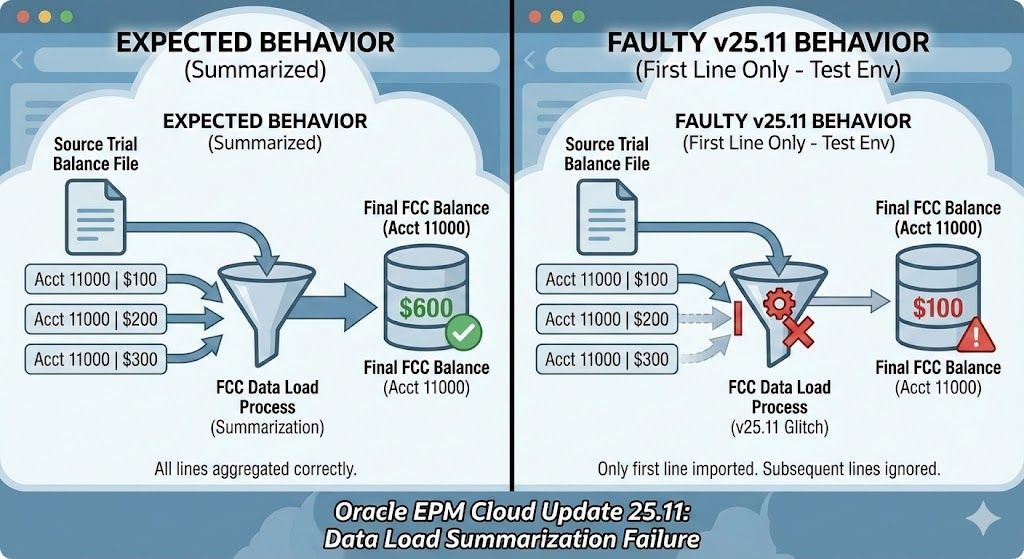Mastering Your Close with Oracle FCC's Supplemental Data
Nadia Lodroman | Oracle EPM Consultant | Integrity in Every Insight.
11 August 2025
Listen to Tresora and Ledgeron's chatting about this blog post:
A Guide to Oracle FCC SDM: Mastering Validation, Posting & Workflow
Your financial close isn't just about trial balances. It’s about the story behind the numbers. What’s your regional headcount? What are your key ESG metrics? What's the detailed breakdown of your debt? This is where Supplemental Data Management (SDM)
in Oracle FCC becomes essential.
SDM is a structured and auditable module for collecting detailed financial and non-financial data that doesn't fit neatly into your general ledger.
Getting Data into the System
You can introduce supplemental data like headcount, ESG metrics, or detailed investment schedules into FCC and Tax Reporting (TRCS) in a few ways:
- Web Forms: The most common method involves users entering data directly into customized web forms.
- Smart View: Finance teams can use the familiar Excel interface via Smart View to download templates, fill them out, and submit them back to FCC.
- Data Integration: For automated feeds, you can use Data Management or EPM Automate to load data directly from source systems like HR or treasury platforms.
The Magic of Validation
SDM's real power lies in its ability to validate data before it hits your consolidation cube. It ensures accuracy by checking data against balances already in the application.
Let's take a common example: a user needs to provide a breakdown of long-term debt by type (e.g., bank loans, bonds). Your trial balance has already been loaded, resulting in a single value in your 'LongTermDebt' account.
You can create a validation rule on the SDM form that checks if the sum of all debt principals entered in this form is equal the total balance of the 'LongTermDebt' account for the current entity and period.
This rule checks the SDM form against the final data input value in the Consol cube, which includes data from all sources (managed data loads, journals, etc.). When the user clicks "Submit," the system instantly checks if the detailed breakdown ties to the GL total. If it doesn't, the submission fails, forcing the user to correct the data at the source. This prevents reconciliation headaches down the line.
The Point-in-Time Validation Trap
It's crucial to understand a key restriction: SDM validations are point-in-time.
The validation check runs only at the exact moment a user clicks "Submit" or "Validate." It does not run continuously. This creates a potential data integrity risk if not managed by your workflow.
Consider this scenario:
- 10:00 AM: An accountant loads the trial balance. Total Investments in Subs shows €5M.
- 10:15 AM: A user opens the SDM form for investment details, enters breakdowns that correctly sum to €5M, and submits it. The validation passes. The task is now with the approver.
- 11:00 AM: The accountant discovers a late top-side journal entry. They post the journal, and the Total Investments in Subs account balance is now €5.5M.
- The Problem: The submitted SDM form, which has already passed validation, is now out of sync with the underlying GL data. The original validation is stale.
Designing a Bulletproof Workflow
To prevent this, you must configure your close workflow with this timing restriction in mind.
- Sequence is Everything: Structure your close tasks so that all data loading and journal posting tasks must be completed and signed off before the related SDM collection tasks become available to users.
- Lock it Down: The best practice is to immediately follow data load/journal tasks with a "Lock" task. Once an entity's data is locked for the period, it cannot be changed. This ensures that the source data for SDM validation is final and reliable.
By enforcing a strict sequence of Load -> Lock -> Collect SDM, you guarantee that your supplemental data is always validated against the correct, final numbers.
Posting: From Detailed Form to Consolidated Number
Once an SDM form is fully approved, the final step is to post the data. Think of this as a highly controlled, unbalanced journal. Instead of debits and credits, you're injecting specific values—like a headcount of 50 or an ESG metric of 1,000 metric tons of CO2—directly into their designated accounts in the consolidation cube.
The true power here is the built-in transparency. When a manager sees the final number in a report, they can drill through from that single value directly back to the original SDM form. This instantly reveals the detailed breakdown, any user comments, and the full approval history. The entire process is governed by its own specific workflow, creating a clear and robust audit trail that shows exactly how that supplemental data entered the final consolidation.
Flexibility: Use What You Need
It’s important to note that the validation and posting features of SDM can be used together or independently, depending on your requirements.
- Validation and Posting: The debt schedule example is a perfect use case. You collect and post the detailed breakdown while also validating it against the GL total.
- Posting Only: You can use SDM to simply collect and post data that has no corresponding GL balance to validate against. This is ideal for purely statistical or non-financial data like regional headcount, office square footage, or key ESG metrics.
- Validation Only: Sometimes, you just need a confirmation. You can use an SDM form as a sophisticated checklist where a user must attest that an offline task is complete. The form's workflow provides an audit trail of the confirmation without posting any numerical data.
Take Your Close to the Next Level
Mastering Supplemental Data Management transforms your close from a number-crunching exercise into a strategic, data-driven process. It enhances data integrity, provides unparalleled transparency, and streamlines collections.
If you're ready to unlock the full potential of your Oracle FCC implementation, let's talk. To discuss how to tailor an SDM solution for your specific needs, please contact us at www.lodroman.com.
Turning financial complexity into operational clarity. Because in Finance, Integrity is Permanent.






